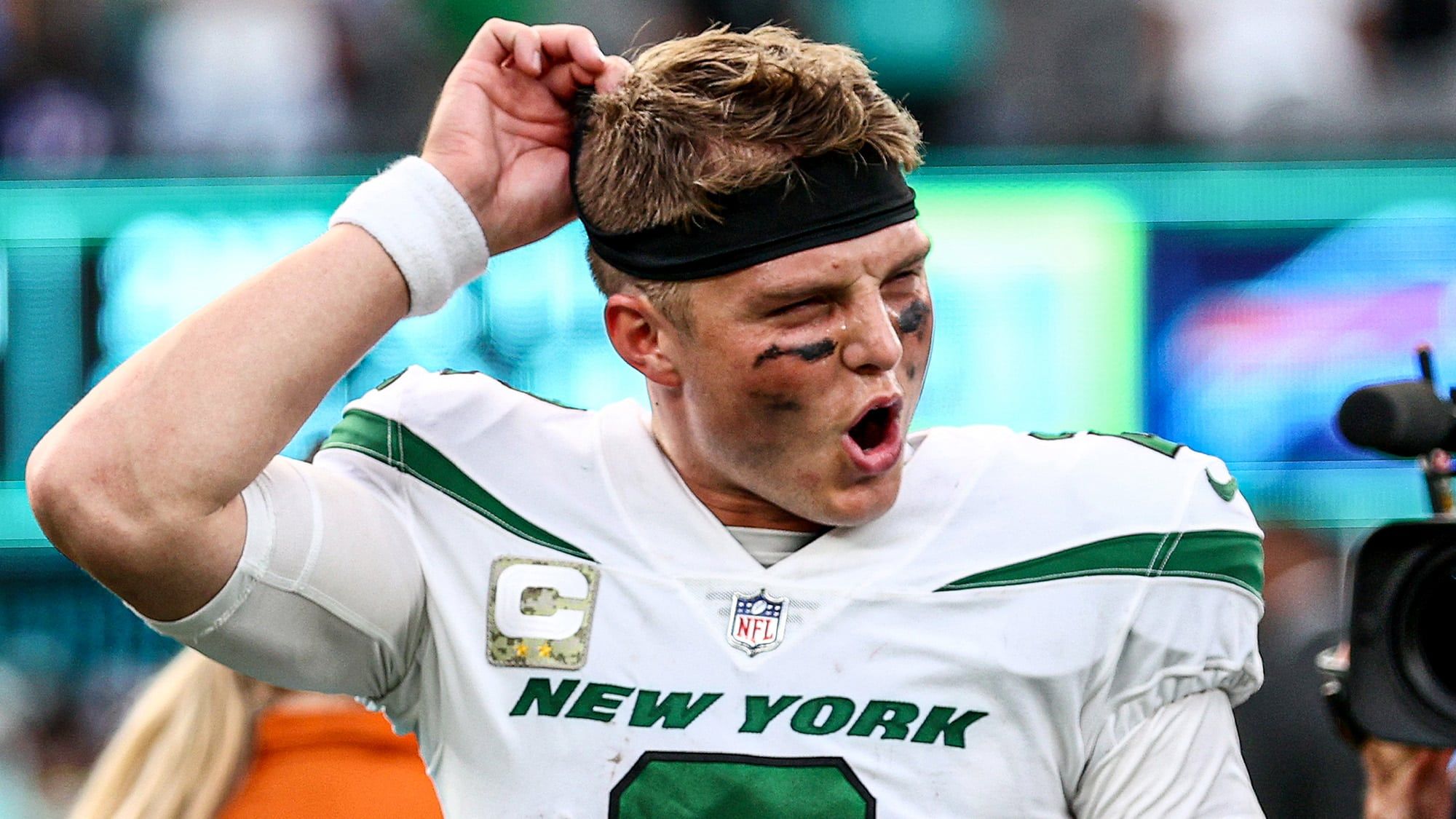A simple philosophical shift was all the New York Jets needed to bring Zach Wilson back to life
Zach Wilson was sputtering. After a promising first two games of his sophomore season, the New York Jets‘ young quarterback strung together three consecutive games of poor play. Worrisome habits from his rookie year had reemerged and were becoming more prevalent each week.
Over his first two games of the 2022 season, Wilson was playing like a perfectly average starting quarterback, which would represent an excellent leap from his rookie year. Wilson averaged 0.00 EPA (Expected Points Added) per dropback from Weeks 4-5, which ranked 14th out of 32 qualified quarterbacks over that span.
But from Weeks 6-8, Wilson stooped to -0.25 EPA per dropback, ranking 29th out of 32 qualifiers. That’s hardly different from his rookie-year average of -0.27, which was the worst mark out of 33 qualifiers in the 2021 season.
Wilson was headed down a dark path. But with one simple fix, Jets offensive coordinator Mike LaFleur rejuvenated his young quarterback in New York’s Week 9 game against the Buffalo Bills.
Following Wilson’s rough Week 8 performance against the New England Patriots, I wrote an article that highlighted some of Wilson’s most notable strengths and weaknesses throughout the 2022 season to that point. One of the main takeaways was that Wilson tended to perform poorly on long-lasting plays and on plays outside of the pocket, but he was actually performing quite well when he got the ball out quickly and stayed in the pocket while doing so.
Here is a look at some of Wilson’s numbers in different types of situations over his first five games – notice how much better he was when playing the quick game from the pocket:
Ranks among 35 qualified quarterbacks
- Passes thrown on designed rollouts: -0.85 EPA per dropback (34th) – 4/11 for 70 yards, 0 TD, 1 INT
- Passes thrown while outside of the pocket: -0.85 EPA per dropback (31st) – 6/31 for 140 yards, 0 TD, 2 INT
- Passes thrown more than 2.5 seconds post-snap: -0.34 EPA per dropback (31st) – 38/90 for 683 yards, 2 TD, 4 INT
- Passes thrown from inside of the pocket in under 2.5 seconds post-snap: 0.20 EPA per dropback (10th) – 40/52 for 365 yards, 1 TD, 1 INT
Against Buffalo, LaFleur did a phenomenal job of adjusting Wilson’s responsibilities to match the strengths and weaknesses that are shown by the numbers above. LaFleur designed an offense that emphasized Wilson’s success as a quick thrower from inside the pocket while hiding his weaknesses on long-lasting plays and on-the-move plays.
The majority of Wilson’s pass attempts against the Bills occurred within the scenario where he produces his best numbers. Wilson threw 16 of his 25 pass attempts from inside of the pocket in under 2.5 seconds after the snap. That makes up 64% of his pass attempts, a new season-high (by a longshot) and a massive increase over the 37% rate Wilson accrued over his first five games.
Wilson enjoyed immense success on these throws. He completed 14 of 16 passes for 116 yards, 1 touchdown, and 0 interceptions. His 117.7 passer rating in these situations ranked second-best among all quarterbacks in Week 9 (pre-MNF) while his 0.51 EPA per dropback ranked fourth-best.
After this standout performance, Wilson now ranks as a truly elite quick-game pocket passer in 2022. Here are his season-long numbers and rankings on passes thrown from inside of the pocket in under 2.5 seconds:
Ranks among 34 qualified quarterbacks
- 54/68 for 481 yards, 2 TD, 1 INT
- 6th in yards per attempt (7.1)
- 4th in completion percentage (79.4)
- 8th in EPA per play (0.27)
- 4th in success rate (57.4%)*- a successful play is considered any play that yields a positive EPA; i.e. a play that keeps the offense “on-schedule”
This is the version of Zach Wilson the New York Jets need right now. The scramble drills, the rollouts, the long-developing deep concepts: all of that can take a back seat until Wilson settles in and gets comfortable with the little things. While those weapons should still be pulled out at the right times (both from LaFleur’s perspective as a play-caller and from Wilson’s perspective as a playmaker), they should not be Wilson’s bread and butter.
When Wilson swiftly gets rid of the ball with rhythm and confidence, he is a stud. That’s the type of quarterback he is at the moment. The flashy stuff can become a larger part of his game once he is further along in his development.
Get Started: Learn More About Becoming A Jet X Member
LaFleur deserves a lot of credit for the philosophical shift against Buffalo, as he undoubtedly constructed a gameplan that was predicated more heavily upon quick-game concepts. But Wilson deserves credit for the stylistic change, too.
Over his three-game cold streak, Wilson himself was responsible for creating many of the unfavorable situations he encountered. Many plays that should have been quick-release, clean-pocket, in-the-pocket throws would turn into long-lasting, under-pressure, on-the-move throws because Wilson did not get the ball out on time and was too willing to leave the pocket.
Against Buffalo, Wilson eliminated those self-inflicted wounds. He looked significantly more calm, poised, and confident in the pocket, working smoothly within the rhythm of the offense. Wilson played his part when it came to preventing the creation of hectic conditions.
It feels as if LaFleur and Wilson have discovered their identity. The Jets will be a legitimate threat throughout the next few months if they can take what they did offensively against Buffalo and extrapolate it over the rest of the season.

